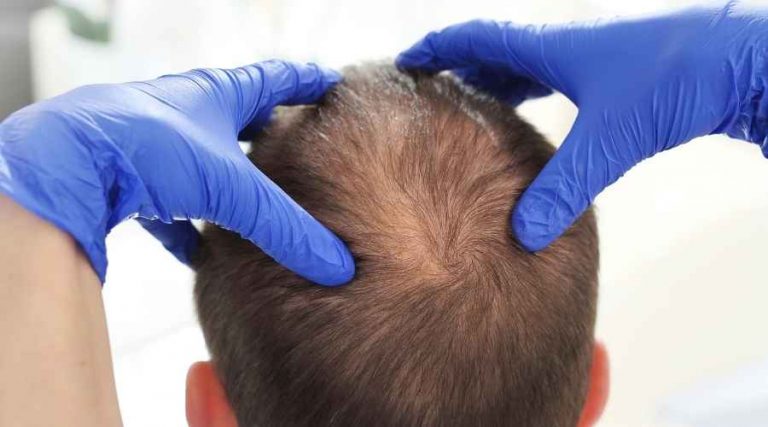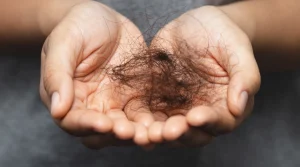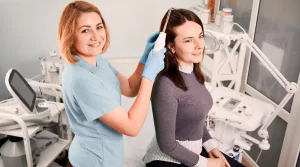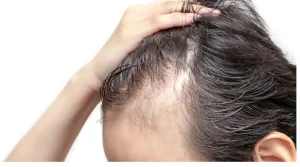Microneedling, also known as derma rolling, is a procedure that stimulates collagen formation in the skin to combat the signs of aging and hair loss. The process involves a skin roller with tiny needles that produce minor skin injuries to treat hair loss without invasive plastic surgeries, making it incredibly popular amongst dermatologists and patients. There’s even empirical evidence that microneedling can help with a particular type of hair loss, known as alopecia areata.
How Does Microneedling Work?
The process of microneedling starts with a device known as a roller that has sharp, tiny needles embedded in it. The healthcare professional rolls this device across the treatment region, inflicting minor injuries. These tiny wounds stimulate the body’s natural healing process and ultimately lead to hair growth. Microneedling can also play an integral role in inducing the release of substances essential for hair growth.
The time for the whole procedure varies depending on the size of the treated region, but it usually takes less than fifteen minutes. After the scalp microneedling session, your healthcare professional may apply a topical balm to the region or provide an injection for pain relief.
Benefits of Microneedling For Hair Loss
Microneedling rose to prominence as a scar treatment in the 1990s. It has since been researched as a possible remedy for androgenic alopecia and alopecia areata.
Besides stimulating collagen formation in the skin, microneedling can also help trigger stem cells in hair follicles, leading to hair growth.
Microneedling also helps hair treatment products, including topical steroids, platelet-rich plasma, and minoxidil, absorb properly in the skin, increasing their efficacy.
Why Should You Never Do Microneedling At Home?
Due to the inexpensive instruments and relatively straightforward method, it might seem easy to try microneedling at home. However, opting for this procedure without any professional help might be too dangerous and lead to excessive hair loss rather than hair growth.
Doing microneedling yourself at home without any professional assistance has numerous drawbacks. These are some of them:
- The majority of individuals do not know how to use the roller correctly.
- Certain sections of your scalp, such as the back of your head, are challenging to reach.
- You don't have the same level of expertise that a professional has.
- There is always an uncertainty of how much pressure to apply.
- You never know when to stop.
- A dilemma of not knowing which needle size to use.
Why is Professional Help Vital for Microneedling?
It is better to consult an experienced professional for microneedling to make sure that you’re getting the proper treatment that can trigger the process of hair growth and mitigate any chances of infection.
Seeking professional help is more expensive; still, it is far too safe and convenient than doing the whole procedure yourself. Here are some reasons why you should schedule an appointment with a dermatologist for microneedling:
It's challenging to perform microneedling yourself:
Using a microneedling device yourself is challenging without inflicting any harm, even with the optimum needle length. If the hair is still present on the head, there is a huge possibility that it will tangle in the microneedling device. It can also become exceedingly dangerous if the needles aren’t sharp enough to make the incisions without causing damage.
Options to manage pain and discomfort are available in a clinic:
If required, a microneedling specialist can numb your scalp to reduce the pain and discomfort caused by the sharp needles, resulting in a more satisfying experience. Also, professional treatment takes far less time—a treatment cycle often gets completed in fifteen to twenty minutes.
Professionals have the right tools for the job:
It’s vital to utilize the right size equipment and needles to avoid harming the scalp. Some microneedling devices have long needles that might cause damage to the scalp, while others have extremely short needles that may not be enough to perform the job appropriately.
Adequate sanitization is crucial:
When not properly sterilized or handled, derma rollers can carry perilous bacteria, causing severe skin infections and breakouts. They can also lead to skin problems, including eczema, painful irritation, and discoloration, such as lumps, redness, or dark spots. Therefore, adequate sanitization of the tools and equipment is indispensable for the microneedling procedure.
All these factors show that seeing a professional is a much more suitable option when it comes to microneedling.
Final Thoughts
It is favorable to consult your healthcare professional or a dermatologist if you are suffering from hair loss. Not only will they answer your questions regarding hair loss and microneedling, but they’ll also recommend an appropriate treatment that suits your individual needs.
Microneedling is a promising hair loss treatment that has proven its worth against genetic conditions like androgenic alopecia. It is recommended not to complete this procedure at home; instead, it is favorable to get it done by licensed professionals (dermatologists and cosmetic surgeons) who specialize in skincare.





